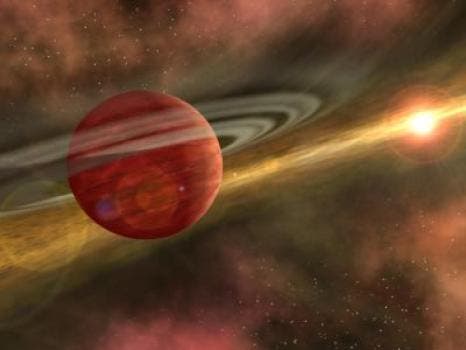The discovery of a giant planet orbiting its star at 650 times the average Earth-Sun distance baffled researchers. So far, they haven’t been able to explain how such a strange system came to be.

The international team of astronomers was led by a University of Arizona graduate student. This is the most distant planet ever found orbiting around a single, sun-like star. As a sidenote, it is also the first exoplanet discovered at the University of Arizona.
The planet in case (HD 106906) has a mass 11 times bigger than that of Jupiter and is 650 times further from its star than the Earth is from the Sun. No currently known mechanism can explain how or why this is happening.
“This system is especially fascinating because no model of either planet or star formation fully explains what we see,” said Vanessa Bailey, who led the research. Bailey is a fifth-year graduate student in the UA’s Department of Astronomy.
There are two main mechanisms of planetary formation currently accepted by astronomers. Planets that form close to their stars from small asteroid-like bodies born in the primordial disk of dust and gas that surrounds a forming star. Since this process is fairly slow, giant plants can’t form this way, only stars comparable in size to Earth. The other one suggests that giant planets can form from a fast, direct collapse of disk material. But there’s a problem with this as well: primordial disks rarely contain enough mass in their outer reaches to allow a planet like HD 106906 b to form. So Bailey started thinking about most exotic solutions.
“A binary star system can be formed when two adjacent clumps of gas collapse more or less independently to form stars, and these stars are close enough to each other to exert a mutual gravitation attraction and bind them together in an orbit,” Bailey explained. “It is possible that in the case of the HD 106906 system the star and planet collapsed independently from clumps of gas, but for some reason the planet’s progenitor clump was starved for material and never grew large enough to ignite and become a star.”
But this model also doesn’t explain things, because the mass ratio of the two stars in a binary system is typically no more than 10-to-1.
“In our case, the mass ratio is more than 100-to-1,” she explained. “This extreme mass ratio is not predicted from binary star formation theories — just like planet formation theory predicts that we cannot form planets so far from the host star.”
Understanding complex, unusual systems like this one is very important – these are the kind of studies that push the border of our knowledge further and further.
“Every new directly detected planet pushes our understanding of how and where planets can form,” said co-investigator Tiffany Meshkat, a graduate student at Leiden Observatory in the Netherlands. “This planet discovery is particularly exciting because it is in orbit so far from its parent star. This leads to many intriguing questions about its formation history and composition. Discoveries like HD 106906 b provide us with a deeper understanding of the diversity of other planetary systems.”


